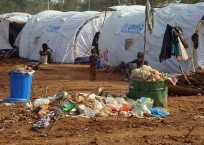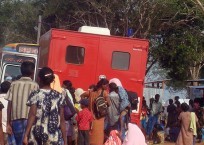
Ilankai Tamil Sangam
Association of Tamils of Sri Lanka in the USA
Published by Sangam.org
by Amnesty International, September 11, 2009
|
Controversy continues over discrepancies in the official count of people in the camps. A report from the Vavuniya District Secretary (the highest ranking local official in the area) to local police stated that as many as 10,000 displaced people who fled the conflict zone through May 2009 were unaccounted for. |
Amnesty International today issued two statements on Sri Lanka, both of which follow below. Both statements, along with a short video clip, can also be found at http://www.amnesty.org/en/news-and-updates/news/sri-lanka-displaced-uncertain-future-government-unlock-camps-20090911. For more information on AI's concerns in Sri Lanka, and to participate in our "Unlock the Camps" campaign, please visit http://www.amnestyusa.org/srilanka. Thanks for your consideration.
 |
Menik Farm camp for internally displaced persons, Sri Lanka, August 2009 |
Only a fraction of nearly 300,000 people who were displaced by recent fighting in the north east of Sri Lanka have been allowed to leave government camps since the war ended in May. More than a quarter of a million people remain detained and under military guard in crowded, unsanitary conditions that are still far below international standards.
The government finally agreed on Tuesday to allow displaced people wishing to leave the camps to stay with relatives who were willing to accommodate them, but families of the displaced told Amnesty International they had not been consulted by the government about the process for leaving and were sceptical of the government’s screening process.
Monsoon rains due in October threaten to swamp tents and flood latrines. Pre-monsoon rains have already flooded some camps and forced people to relocate within the camps. However, the government of Sri Lanka, citing varying security concerns, has continued to prevent people from leaving.
"If the government follows through on its promise, it could considerably reduce overcrowding," said Yolanda Foster of Amnesty International. "The next hurdle these people face is the bureaucracy associated with the government’s ‘screening’ process, which is intended to weed out members of the Liberation Tigers of Tamil Eelam it says are still hiding within the civilian camp population."
One family member of the displaced held at Manik Farm reacted with caution to the announcement. "The government has made many promises... we cannot be certain that our relatives will be offered a chance to leave, they will probably get caught up in unnecessary red tape and delays."
Nobody but the authorities really knows how the screening works or what criteria they use to determine if someone is a security threat – all that is known is that it takes time. By the end of August, the government said that it had registered about half of the newly displaced people. This means that there must be about 130,000 to go.
The government has also said that it has detained about 10,000 people suspected of ties to the Tamil Tigers – the real numbers could be higher. These detainees are held without charge or trial, in what are described by the government as "rehabilitation camps". Their whereabouts and conditions of detention in many cases are unknown.
The International Red Cross (ICRC) said Friday that it is being denied access to these detainees. Incommunicado detention has been shown to greatly increase the risk of torture and extrajudicial killing. There is a long history of both in Sri Lanka.
Cabinet Minister Mahinda Samarasinghe told UN Secretary General Ban Ki-Moon in early September that the government would re-settle displaced people in the North as soon as the de-mining process was completed and infrastructure and basic services were restored. However, true reconstruction and resettlement of areas devastated by war could take many months.
Playing with Words
"'Resettlement', 'return' and 'release' are terms that are often used interchangeably to discuss the fate of Sri Lanka’s displaced people," according to Yolanda Foster. "Resettlement and ‘return’ imply durable solutions to the problem of displacement. 'Release' simply means people are free to go."
"As an immediate matter, the government should allow freedom of movement for all the displaced, even if durable solutions such as resettlement take longer. All Sri Lankan citizens have a right to liberty and freedom of movement, regardless of where they reside.
"In the case of displaced people, this means both choosing long-term accommodations and more temporary arrangements, such as staying with family members or friends. If they choose to remain in the camps for want of a better alternative, displaced people should also be at liberty to come and go."
Durable solutions to Sri Lanka’s massive displacement problem will not happen overnight. De-mining, where necessary, is time consuming, costly and difficult; rebuilding infrastructure takes time. When displaced civilians are freed from camps and allowed to return to their home areas, they may well have to live in temporary accommodations for a long time while they rebuild their lives.
Judging from earlier efforts to find durable solutions for displaced civilians in Sri Lanka – including people displaced by natural disasters outside the conflict zone – it could be years before many of them are effectively "settled."
Controversy continues over discrepancies in the official count of people in the camps. A report from the Vavuniya District Secretary (the highest ranking local official in the area) to local police stated that as many as 10,000 displaced people who fled the conflict zone through May 2009 were unaccounted for.
This discrepancy may be due to several factors: bad record keeping; some detainees escaping the camps by bribing officials; and, of most concern, the unknown fate of thousands of displaced people, many of them suspected of being LTTE cadres, in the custody of Sri Lankan authorities. Enforced disappearances have been reported by families in the camps.
The government’s ban on most international protection activities remains in place. Humanitarian workers are not allowed to talk to camp inmates or to enter tents in the camps.
"Without independent monitoring of the human rights situation in the camps and unimpeded human rights protection activities by humanitarian agencies, it is difficult verify these reports," said Yolanda Foster.
"A transparent, independently monitored screening and registration process would provide a more accurate count of the number of people detained in the camps, would help facilitate family reunification and releases, and could help identify the whereabouts of people who may have been have arrested."
 |
Menik Farm camp for internally displaced persons, Sri Lanka, August 2009 |
© 1996-2025 Ilankai Tamil Sangam, USA, Inc.